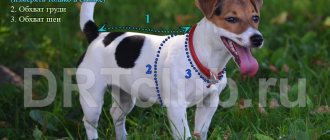Sterile interdigital furunculosis in dogs
Diagnosis Treatment
The origin of a disease such as sterile interdigital furunculosis in dogs is still not clear. According to some hypotheses, the occurrence of this disease is an inflammatory response to triglycerides and keratin, which enter the skin from destroyed hair follicles, subcutaneous tissue, and sebaceous glands. It is also assumed that this condition continues to develop even after the original cause of the disease ends. It is worth noting that representatives of breeds with short hair are most prone to this disease.
The disease can be localized on either a single or several limbs. This disease manifests itself in the form of multiple or single papules, dense nodules or formations. It is often located in the area between the fingers, accompanied by itching and pain, and sometimes by the formation of ulcers and fistulas, with purulent discharge. In advanced cases, tissue fibrosis develops. Lesions can disappear as spontaneously as they appeared; they are characterized by intensification and attenuation of the manifestations of the disease. The disease may be complicated by the development of secondary infections.
Sometimes interdigital furunculosis in short-haired dogs can be caused by atopic dermatitis. Also, the cause of this disease can be “ingrown” hairs between the fingers of animals.
Causes of lumps appearing under the skin on the back, neck, paw, belly and other parts of the dog’s body
One of the most common reasons for the appearance of a lump on the back, abdomen and other parts of the body is a lipoma, or wen. The seal is movable and does not cause any unpleasant sensations when touched. This defect usually occurs due to a dysfunction of the sebaceous glands. Other reasons for the appearance of a tumor in a dog are:
Depending on the cause of the appearance, lumps can be tumor or non-tumor. The latter do not pose any particular danger and pass quickly. The first ones never resolve on their own and require treatment from a doctor. To determine the type of tumor, it is not enough to simply compare it with pictures in a veterinary encyclopedia. However, a general acquaintance with the types of neoplasms will allow the dog owner to understand whether it is worth rushing to see a specialist, or whether it can wait.
Non-tumor formations
Growths under the skin of an animal can appear on the hind or front paw, forehead, cheek, side, thigh, penis and other organs. It is impossible to determine their danger solely by location.
The location of the growth helps to understand in which direction to look for the cause. The following non-tumor formations are distinguished:
- Hernia.
This formation cannot be classified as a tumor, but outwardly it often looks like a large ball. Usually located on the stomach and groin area. - Hematoma.
A seal that usually appears as a result of damage to blood vessels. Sometimes a hematoma in the area of a joint, knee or elbow indicates a fracture of the limb. - Cyst.
Such a growth, which can form in any part of the animal’s body, is usually discovered by chance. A common location for cysts in dogs is on the paws between the toes. Often cysts form in the mouth of animals under the tongue. In this case, the dog’s tongue will always hang to one side.
- Surgical excision.
If the disease has not gone too far, the dangerous lump is cut out with a scalpel. Often, not only the tumor itself is excised, but also adjacent tissues, since it is difficult to detect its real borders. - Irradiation.
Since even surgical removal of the growth does not guarantee complete elimination of the source of the disease from the body, after the operation the dog is prescribed a course of radiation therapy. This helps kill mutated cells that can cause a new tumor. - Chemotherapy.
If an animal cannot undergo surgery due to the spread of metastases, it is prescribed a course of cancer-killing drugs. Often after chemotherapy it becomes possible to perform surgery and save the pet.
All three methods are often used to treat cancerous tumors. They do not provide a 100% guarantee of recovery, but they can significantly prolong the life of a sick dog.
Treatment
First of all, it is necessary to make sure that the cause that caused the development of this disease has been identified and eliminated.
If a secondary infection develops, long-term (at least one and a half months) antibiotic therapy is prescribed.
Single lesions can be removed surgically or using a laser.
Cleansing wipes containing chlorhexidine and other antimicrobials can help control the spread of disease. In addition, to speed up recovery, damaged follicles and ingrown hairs are removed surgically or using a laser.
When cysts form, dimethyl sulfoxide with enrofloxacin and steroids is used topically. It is important to remove ingrown hairs.
In some patients, the administration of niacinamide and tetracycline achieves recovery. The effectiveness of treatment will be indicated by positive dynamics after a month and a half course. The treatment is long-term.
In some cases, doxycycline (or tetracycline) is prescribed, as well as cyclosporine, sometimes with the addition of ketoconazole. After achieving a positive effect, the dose is reduced to the minimum effective.
For cases that cannot be treated surgically, glucocorticosteroids can be used. Improvement should occur within two weeks, after which the dose of the drug is gradually reduced to the minimum effective. Ultimately, your health condition may allow you to stop using the drug. If secondary infections occur, they must be treated quite aggressively.
In order to maintain a state of remission, medication may be required throughout the animal's life.
(c) Veterinary center for the treatment and rehabilitation of animals “Zoostatus”. Varshavskoe highway, 125 building 1. tel.
Reasons for appearance
Based on many years of practice, veterinary specialists distinguish the following causes for the development of pustular infection in dogs:
- Skin contamination. Walking in bad weather or being kept in a dirty room leads to the accumulation of dirt and dust on the surface of the pet’s fur and skin and provokes the development of boils.
- Unsatisfactory living conditions. Too humid air, drafts, sudden changes in temperature in the room lead to disruption of the natural protective balance of the skin.
Street dog with weakened immune system
- Injuries. Microcracks, cuts, abrasions, mechanical and thermal damage to the skin violate the integrity of the dermis and provoke the introduction of pathogenic microflora. Scratching with paws due to allergies, fungal diseases, and dermatitis of various etiologies can also lead to illness.
- Metabolic disease. Hormonal imbalances, diseases of the thyroid and pancreas contribute to changes in the balance in the body and provoke furunculosis in animals. Seborrhea is often the cause of multiple ulcers in dogs. The pathology is associated with dysfunction of the sebaceous glands, disruption of the process of sebum rejection.
- Inadequate care of your pet's coat. The use of sharp combs and combs to tidy the coat, the use of shampoos that do not meet the structural characteristics of the coat leads to microtrauma and disruption of the natural fat balance of the skin.
- Poor nutrition. A deficiency in the diet of nutrients such as vitamin A, ascorbic acid, taurine, folic acid, iron, and sulfur-containing amino acids leads to a decrease in the protective properties of the skin and makes it vulnerable to infection.
Veterinarians note that the cause of furunculosis in dogs is often chronic diseases of the digestive system and kidneys, anemia of various origins, prolonged and severe stress, and depressive states.
Most often, according to dog breeders and veterinarians, the development of boils is observed in representatives of such breeds as Shar-Pei and bulldogs. This predisposition is associated with the folded structure of the skin and its poor ventilation. The disease is also common in golden retrievers, terriers, collies, and German shepherds.
We recommend reading about how to treat a wound in dogs. You will learn about the classification of injuries, the features of treating superficial and deep, weeping and lacerated wounds. And more about osteomyelitis in dogs.
Signs of a boil on the nose, head, leg
The inflammatory process can be local, local and general in nature. In the local form, a single boil is observed. Localized pathology is characterized by the presence of several inflammatory foci on a separate part of the body, for example on the head. With general furunculosis, damage to the entire skin of the animal is noted.
In clinical practice, a veterinarian most often deals with ulcers located on the pet’s face and limbs. There are also interdigital and perianal furunculosis. The cause of the development of a purulent abscess in the interdigital area is most often trauma, wounds, and fungal dermatitis. Perianal furunculosis develops as a complication of demodicosis in dogs.
Symptoms of a purulent skin infection are as follows:
- Single or multiple nodules are observed on the skin.
- The swelling has a dense consistency. There is redness of the skin.
- As the abscess develops, the color changes to yellow-gray.
- The animal shows restlessness: it scratches its paws, rolls on the floor, rubs its sides against walls and furniture.
a) Interdigital boil; b) Furunculosis on a dog’s face
Having reached a certain stage, the boil spontaneously opens and purulent contents flow out of it.
Causes
The causes of an interdigital cyst can be completely different, mainly infection, allergic reactions and parasites, a dirty bed, and environmental humidity. A cyst can occur as a single formation or multiple, affecting one paw or several at once. The location of the cysts is quite painful, and the process of suppuration is not pleasant. To protect your dog from such troubles, you should not hesitate to go to a veterinary clinic to see a highly qualified specialist.
Stages and forms of occurrence
Under favorable conditions, conditionally pathogenic staphylococci that have penetrated into damaged tissues begin to actively develop. The inflammatory process involves the sebaceous gland located next to the hair follicle, as well as neighboring dermal tissues. The purulent process occurs in the following stages:
- Infiltration (initial). During this phase, swelling and redness of the skin are observed. The waste products of white and aureus staphylococci cause irritation of nerve endings, which is accompanied by pain in the inflamed area upon palpation.
As a rule, this stage of boil development remains unnoticed by the owner of a furry pet due to the thick fur. The dog may become restless and try to scratch the affected area.
- Suppuration phase. The inflammatory process progresses, the body's defense system actively fights the infection through phagocytosis. Blood flow increases in the surrounding tissues, and severe redness is observed. The body's fight against invading microbes leads to the formation of pus in the area of inflammation. When the boil is localized on a limb, the dog begins to limp.
An abscess under the armpits, on the inside of the thigh leads to the pet’s reluctance to run due to painful sensations. During this phase, the formation of a necrotic core occurs. The animal often experiences a rise in body temperature, lethargy, apathy, and refusal to feed. Surgical removal of the boil at this stage prevents its spontaneous opening and the spread of purulent infection to healthy tissue.
- Self-dissection. During this phase, the purulent contents melt and come out. According to veterinary experts, independent cleansing of the skin from purulent contents leads to an expansion of the infection zone and is extremely undesirable for animals with a weakened immune system.
- Healing. After the purulent masses are rejected, the wound surface begins to heal. Redness and swelling in the affected area decreases. The source of inflammation becomes covered with a crust, after which, when rejected, a scar or a bluish stain may remain in place of the boil.
Treatment of boils in dogs
In veterinary practice, treatment of purulent skin infections is carried out using surgical and conservative methods. The opening of the boil is carried out at the stage of suppuration, when a necrotic core is formed. The veterinary surgeon makes a cross-shaped incision and cleans the lesion from purulent contents. The manipulation is performed under local anesthesia. In practice, infiltration novocaine blockades with an antibiotic are often used.
If necessary, the cavity is washed with disinfectant solutions - Chlorhexidine, Furacilin, Miramistin. An anti-inflammatory ointment, for example Tetracycline, is placed in the cavity. After surgical opening of the abscess, measures are taken to prevent scratching. The animal may be wearing a special protective collar.
In the case when the development of the boil is at the infiltration stage, first of all the owner must cut the hair to provide access to the damaged area. Veterinary experts recommend using alcohol compresses during this phase of inflammation. 70-proof alcohol is used to make them.
In order to accelerate the maturation of the abscess, anti-inflammatory ointments are used, for example Vishnevsky's liniment, Synthomycin and Ichthyol ointment. Warming compresses are canceled in this case.
Treatment of advanced forms of furunculosis cannot be done without the systemic use of antibacterial agents. To treat the disease in veterinary practice, penicillin antibiotics, tetracyclines, and cephalosporins are widely used.
From a series of penicillin drugs, drugs such as Bicillin, Ampicillin, Amoxiclav, Sinulox and others are effective against streptococci. Veterinarians prescribe Doxycycline and Metacycline as tetracycline drugs for furunculosis in dogs. Cephalosporins - Cephalen, Cobactan, Ceftiomax, Cefkinor, etc. - have a good antibacterial effect on white and golden staphylococci.
Antibiotics for the treatment of furunculosis in dogs
In the pathophysiology of furunculosis, the pet’s immunity is of paramount importance. In this regard, successful treatment of purulent skin infection cannot be done without restorative drugs. First of all, a sick dog is prescribed a course of immunomodulatory agents that increase the phagocytic abilities of cells and local protection of the epidermis. For this purpose, Gamavit, Maxidin, Roncoleukin, Nucleopeptide, etc. are used.
Vitamin therapy for furunculosis is based on intramuscular injections of ascorbic acid and riboflavin. Multivitamin supplements with a high content of iron, folic acid, vitamin A and E are introduced into the diet. Adding brewer's yeast to the diet has a good effect.
During the treatment period, it is strictly forbidden to bathe a sick animal. Water procedures for purulent infection contribute to the spread of the inflammatory process to healthy tissue.
Therapeutic techniques
As we mentioned above, the treatment method is quite “simple” - only surgical intervention.
Drug treatment is ineffective (again, we have already said why).
The simplest version of the operation is the so-called “podoplasty”, that is, partial excision of the pads of the paws and, possibly, the fingers. Unfortunately, simplicity and economy are the key to frequent side effects, which include severe lameness and, subsequently, frequent relapses. Therefore, today many veterinarians are inclined to believe that the only effective method is complete surgical amputation of the affected tissue
.
Nowadays, surgery to remove an interdigital cyst is not so “barbaric”; laser therapy is widely used
. The method for performing this procedure is well documented. A 70% success rate is reported. But here it is important to take into account that only a good veterinary surgeon can perform the operation so that your dog fully recovers, and therefore it is better not to skimp on the clinic.
If everything is done perfectly, the wound heals by primary intention within about two weeks. Postoperative care consists of prescribing systemic and local antibacterial drugs, non-steroidal anti-inflammatory drugs. Please note that in the first two weeks you need to strictly limit the dog’s movements and constantly change the bandages (so it is better to leave the pet in the clinic for this period). In severe and advanced cases, unfortunately, relapses are not uncommon, so the operated dog needs to be examined regularly even after its discharge from the clinic.
A growth on a dog’s paw is a subcutaneous lump, the size of which can vary from a couple of millimeters to several centimeters. Such seals are quite common in dogs.
There are both completely harmless formations and dangerous ones, so it is necessary to regularly examine your pet and, if there are unknown growths, have the animal examined by a veterinarian.
Prevention
In order to prevent the development of furunculosis in dogs, veterinary experts recommend that owners adhere to the following rules and advice:
- Keep the animal in proper sanitary conditions.
- After a walk, remove dirt from the pet’s coat and limbs.
- Regularly clean the coat, fight tangles, and bathe the dog using special shampoos.
- Monitor the state of the animal's immune system. Strengthen your pet’s body with multivitamin complexes after preliminary consultation with a veterinarian.
We recommend reading about gangrene in dogs. You will learn about the causes of gangrene, types of gangrene in dogs and their characteristics, drug and surgical treatment, and prevention of development. And more about a purulent wound in a dog.
The formation of boils on a dog’s body is not such a rare occurrence. As a rule, animals with a low level of immune defense suffer from the disease. Skin hygiene and the hormonal status of the body play an important role in the development of inflammation.
Treatment should be comprehensive and include the use of both local anti-inflammatory drugs and systemic use of antibiotics. Often, the veterinarian resorts to surgical opening of the abscess.
>Useful video
To learn how novocaine blockades are carried out when opening a boil in dogs, watch this video:
What to do?
You should definitely keep an eye on your pet . If there is such an opportunity, it is worth purchasing special shoes for your dog, this way you will be able to protect his paws from punctures that lead to growths and cysts. Of course, this is largely not a question of price, but whether the dog can learn to walk in boots if he walks without them from an early age.
After each walk, it is recommended to inspect the animal’s paws. If possible plant shoots, dry sticks, spikelets have been found that can lead to an interdigital cyst, you should immediately remove them and wash them with a solution of potassium permanganate or Furasemide dissolved in water.
Monitor your pet's behavior; if he pays excessive attention to licking his paws, or begins to limp for no reason at first glance, then there is no need to delay. Only your timely intervention will not only protect him from pain and discomfort, but also save the dog’s life. You should not neglect your pet’s health, thinking that the abscess will mature and come out on its own. It is foolish to believe that “everything heals on a dog”; of course, the healing process is observed in animals much faster than in people, but in this case it is impossible to do without the help of qualified specialists.
A growth on a dog’s paw is a subcutaneous lump, the size of which can vary from a couple of millimeters to several centimeters. Such seals are quite common in dogs.
There are both completely harmless formations and dangerous ones, so it is necessary to regularly examine your pet and, if there are unknown growths, have the animal examined by a veterinarian.











